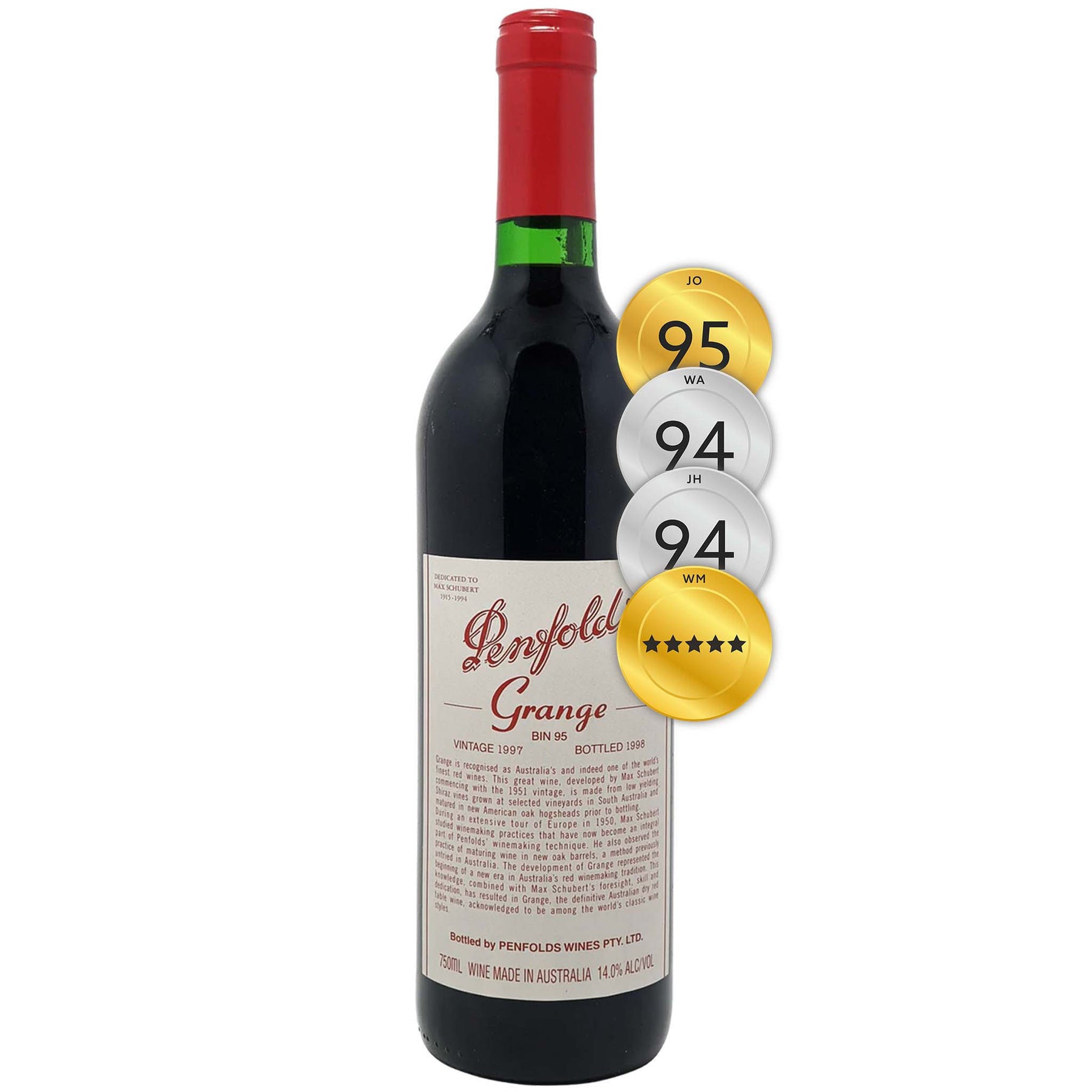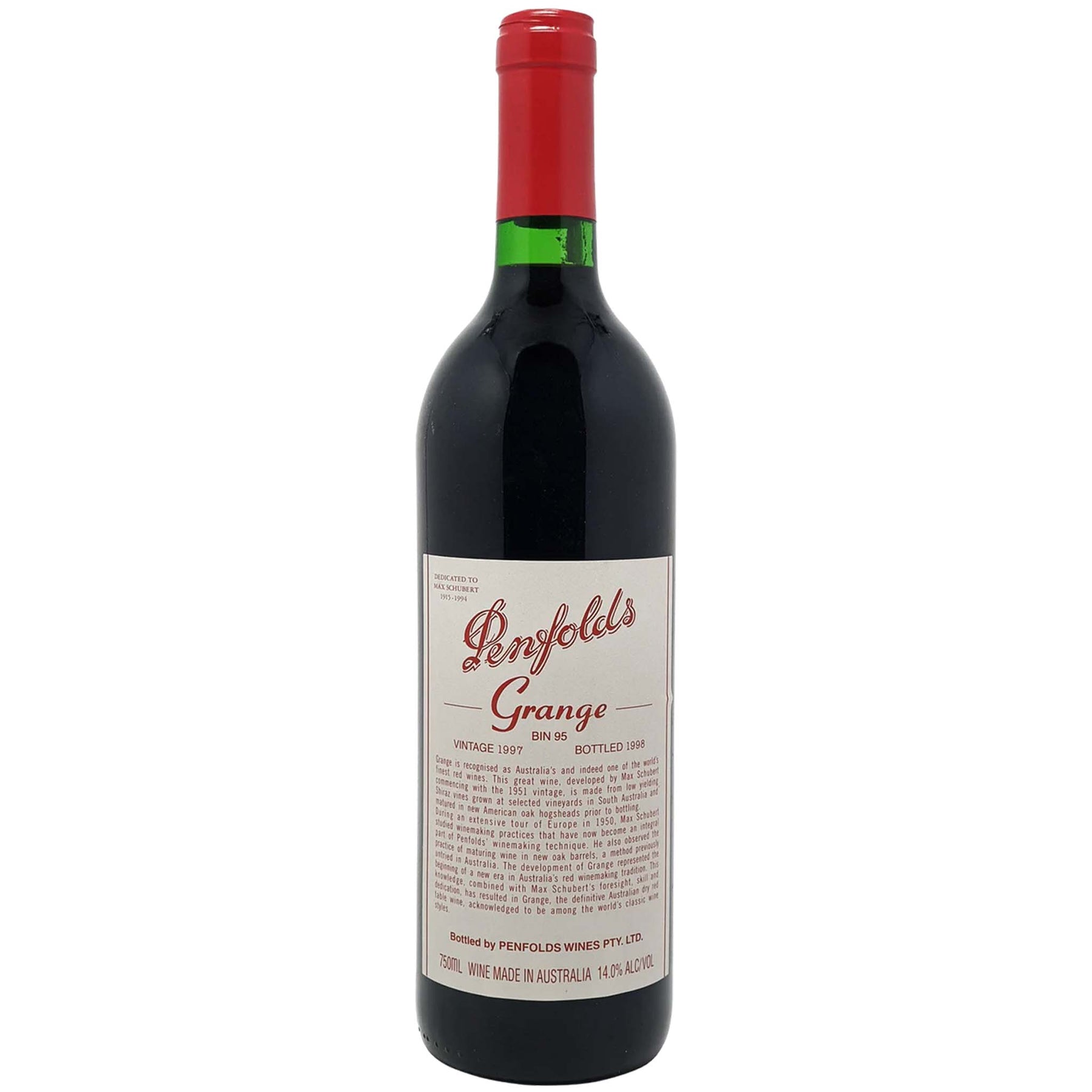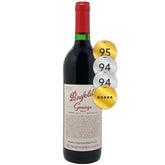

Penfolds Bin 95 Grange 1997
Style: Red Wine
Varieties: Shiraz (96%), Cabernet Sauvignon (4%)
Closure: Cork
Penfolds Bin 95 Grange 1997
Warehouse
34 Redland Drive
Vermont VIC 3133
Australia
Critic Score: 95
Alcohol: 14.5 %
Size: 750 ml
Drink by: 2035
Penfolds Bin 95 Grange Shiraz is Australia's most famous wine with a reputation for superb fruit complexity and flavour richness. It is the most powerful expression of Penfolds multi-vineyard, multi-district blending philosophy and is officially listed as a Heritage Icon of South Australia. One of the world's great wines.
"A big, typical Grange and a very good wine from this vintage. Smooth, sumptuous and firmly structured, its deep, long palate of dark red and black berry flavours is wound around firm, but powder-fine tannins, finishing spicy and savoury." Jeremy Oliver
The 1997 Penfolds Grange is a blend of 96% shiraz and 4% cabernet sauvignon from premium vineyards in the Barossa Valley (including the Kalimna vineyard), McLaren Vale and Limestone Coast. The wine was matured for 20 months in American oak hogsheads (100% new).
"A deep, crimson red with a dense ruby core. Nose: Immediately engaging, with wafts of nutmeg and ginger amongst notes of blueberry and blackcurrant and a background of well-seasoned savoury oak. The fruit gains in the glass with aeration, when more subtle perfume and chestnut complexities emerge. Palate: Already showing excellent balance within the frame of a beautifully interwoven mesh of dark plum and blackberry fruits with fig and liquorice. Complex fruit and spice flavours sit against a finely focused backdrop of firm but rounded tannins." Penfolds Rewards of Patience VI Edition, 2008.
"Deep crimson. Meaty, leafy, red cherry, redcurrant, graphite, tobacco aromas with herb garden, aniseed and iodine/seaweed/ soy notes. Ample redcurrant, red cherry and mocha flavours with soy, demi-glace and nutty notes, fine lacy al dente and sinewy tannins and underlying coconut and vanilla oak nuances. Finishes sinewy firm dry with soupy demi-glace and meaty soy notes. Drinking well, but will improve with time. Peak drinking now to 2035.
Vintage Conditions: A somewhat challenging vintage combining a cool start to the season with heat in the high summer. Budburst was slightly later than usual in most South Australian regions, with mild weather through to Christmas. The onset of a prolonged heat wave in February further delayed ripening. Fortunately, a sunny, warm autumn followed, allowing vines to reach full ripeness." Penfolds
Expert reviews
"A big, typical Grange and a very good wine from this vintage. Deep red with ruby edges, its slightly cooked aromas of blackberries, dark plums and prunes, licorice and currants are distinctly spicy. Smooth, sumptuous and firmly structured, its deep, long palate of dark red and black berry flavours is wound around firm, but powder-fine tannins, finishing spicy and savoury. Drink 2017-2027+." Jeremy Oliver – 95 points
"The 1997 Grange (a blend of 96% Shiraz and 4% Cabernet Sauvignon) looks to be a classic Grange, although slightly softer and more forward than the backward 1996. The saturated purple-colored 1997 offers a gorgeously sweet nose of blackberry liqueur, cherries, camphor, chocolate, plums, and mocha. The wine is opulently-textured, extremely soft, layered, and seductive, with Grange's tell-tale personality well-displayed, but in a seamless, seductive style. This is a superb Grange that can hold its own against the more heralded 1996. Anticipated maturity: 2005-2022." Robert Parker, Wine Advocate - 94 points
"Medium to full red, with just a touch of purple remaining; powerful, complex dark fruits, chocolate and savoury lemon/vanilla oak on the bouquet, then a similarly powerful palate where earth and chocolate join the chorus of flavours promised by the bouquet; persistent tannins, of course. It's hard to suggest this will be regarded as a great Grange in 20 years or so, but it is nonetheless in the mainstream of Grange style. Best Drinking: 2007-2022." James Halliday - 94 points
"A huge wine with a lovely deep mauve colour. An impressive, inky perfumed nose. The palate is big and rich with a lovely balance of licorice-like oak and stewed plum fruit flavour. Plenty of tannins and acid here - it just needs lots of time!" Winestate Magazine ★★★★★
After the success of early sherries and fortified wines, founders Dr Christopher and Mary Penfold planted the vine cuttings they had carried on their voyage over to Australia. In 1844 the fledging vineyard was officially established as the Penfolds wine company at Magill Estate.
As the company grew, so too did Dr Penfold's medical reputation, leaving much of the running of the winery to Mary Penfold. Early forays into Clarets and Rieslings proved increasingly popular, and on Christopher's death in 1870, Mary assumed total responsibility for the winery. Mary's reign at the helm of Penfolds saw years of determination and endeavour.
By the time Mary Penfold retired in 1884 (ceding management to her daughter, Georgina) Penfolds was producing 1/3 of all South Australia's wine. She'd set an agenda that continues today, experimenting with new methods in wine production. By Mary's death in 1896, the Penfolds legacy was well on its way to fruition. By 1907, Penfolds had become South Australia's largest winery.
In 1948, history was made again as Max Schubert became the company's first Chief Winemaker. A loyal company man and true innovator, Schubert would propel Penfolds onto the global stage with his experimentation of long-lasting wines - the creation of Penfolds Grange in the 1950s.
In 1959 (while Schubert was perfecting his Grange experiment in secret), the tradition of 'bin wines' began. The first, a Shiraz wine with the grapes of the company's own Barossa Valley vineyards was simply named after the storage area of the cellars where it is aged. And so Kalimna Bin 28 becomes the first official Penfolds Bin number wine.
In 1960, the Penfolds board instructed Max Schubert to officially re-start production on Grange. His determination and the quality of the aged wine had won them over.
Soon, the medals began flowing and Grange quickly became one of the most revered wines around the world. In 1988 Schubert was named Decanter Magazine's Man of the Year, and on the 50th anniversary of its birth, Penfolds Grange was given a heritage listing in South Australia.
Despite great success, Penfolds never rests on its laurels. In 2012 Penfolds released its most innovative project to date - 12 handcrafted ampoules of the rare 2004 Kalimna Block Cabernet Sauvignon.
Two years later, Penfolds celebrated the 170th anniversary – having just picked up a perfect score of 100 for the 2008 Grange in two of the world's most influential wine magazines. Today, Penfolds continues to hold dear the philosophies and legends – '1844 to evermore!'.

South Australia
South Australian is responsible for more than half the production of all Australian wine. It is home to more than 900 wineries across 18 wine regions. The regions are Adelaide Hills, Adelaide Plains, Barossa Valley, Clare Valley, Coonawarra, Currency Creek, Eden Valley, Kangaroo Island, Langhorne Creek, McLaren Vale, Mount Benson, Mount Gambier, Padthaway, Riverland, Robe, Southern Fleurieu, Southern Flinders Ranges and Wrattonbully.
Many of the well-known names in the South Australian wine industry established their first vineyards in the late 1830s and early 1840s. The first vines in McLaren Vale were planted at Reynella in 1839 and Penfold's established Magill Estate on the outskirts of Adelaide in 1844.
South Australia has a vast diversity in geography and climate which allows the State to be able to produce a range of grape varieties - from cool climate Riesling in the Clare and Eden Vallies to the big, full bodied Shiraz wines of the Barossa Valley and McLaren Vale. Two of Australia's best-known wines, Penfolds Grange and Henschke Hill of Grace, are produced here. There is much to discover in South Australia for the wine lover.




